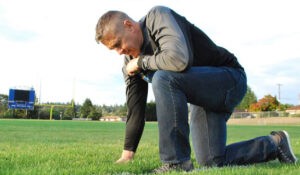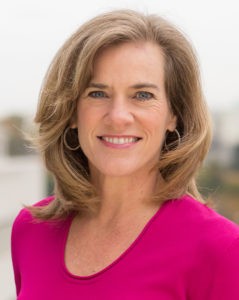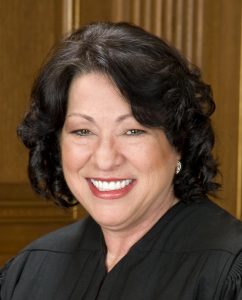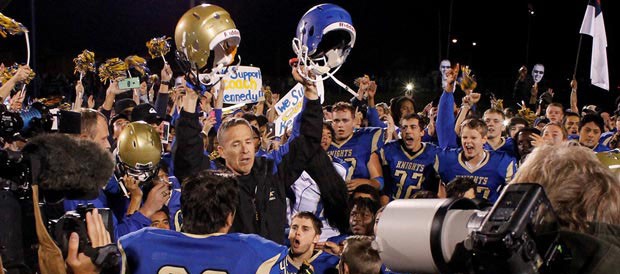In one of the most consequential religious liberty cases in modern history, the United States Supreme Court June 27 solidified the current majority’s preference for free expression of religion over the constitutional ban on establishing religion.
To the dismay of traditional church-state separationists and to the joy of conservative evangelicals, the high court sided with an assistant high school football coach who was fired for refusing to stop holding Christian prayer times at the 50-yard line immediately after games.
Although the court’s 6-3 majority opinion said these were “private” prayers and therefore allowed, the dissenting justices showed photographic evidence of large crowds of players and fans gathered around the coach for post-game prayers.
Under decades of court precedent, government employees — and particularly those working with minors — are not allowed to show favoritism for one religion over another or to use the workplace to coerce others to join in their religious expression.
Ignoring the facts?
Justice Sonia Sotomayor, writing in dissent for herself and Justices Stephen Breyer and Elena Kagen, accused her conservative colleagues on the court of ignoring the plain facts of the case to come to an outcome they desired.
“To the degree the court portrays petitioner Joseph Kennedy’s prayers as private and quiet, it misconstrues the facts.”
“To the degree the court portrays petitioner Joseph Kennedy’s prayers as private and quiet, it misconstrues the facts,” she wrote. “The record reveals that Kennedy had a longstanding practice of conducting demonstrative prayers on the 50-yard line of the football field. Kennedy consistently invited others to join his prayers and for years led student athletes in prayer at the same time and location. The court ignores this history.
“The court also ignores the severe disruption to school events caused by Kennedy’s conduct, viewing it as irrelevant because the Bremerton School District stated that it was suspending Kennedy to avoid it being viewed as endorsing religion.”
What’s next for the coach?
The assistant coach who sued the Bremerton, Wash., school district — Joseph Kennedy — had moved to Florida in the seven years since he was fired and the case was filed. His case had been denied by every lower court and had been turned down for review by the U.S. Supreme Court until he tried again after the court obtained a conservative supermajority last year. That time, the court agreed to hear the case it previously denied.

Joseph Kennedy in a photo provided by his law firm, First Liberty Institute.
According to interviews Kennedy gave to various media outlets June 27, he intends to move back to Washington state and get back his old job. Whether that is possible under school district policy was not immediately clear. Nor was it clear under what conditions he could resume his previous public prayer practices and remain in compliance with the narrow window the court majority used to evaluate his case.
A key question is what might be considered “private” and what might be considered coercive.
The Bremerton School District issued a brief statement, including this: “In light of the court’s decision, we will work with our attorneys to make certain that the Bremerton School District remains a welcoming, inclusive environment for all students, their families and our staff. We look forward to moving past the distraction of this seven-year legal battle so that our school community can focus on what matters most: providing our children the best education possible.”
National reaction
Once again, reaction to the court’s latest ruling sharply divided the religious community and drew rebuke from church-state separationists.
One thing all sides agree on is that conservative evangelicals like Kennedy believe they are discriminated against by laws and previous court rulings they think infringe upon their right to freely practice their religion. What critics point out in return is that these Christians want rights for themselves they are not willing to grant others.
A common retort after the high court’s ruling was to ask whether the outcome would have been the same if the assistant coach were a practicing Muslim or even a Mormon. As with its recent decision on abortion and another religious liberty case decided last week, the court majority appears to be giving conservative evangelicals unfettered access to practice their religious beliefs in public even if that impinges on the rights of others.
“The U.S. Supreme Court today gutted decades of established law that protected students’ religious freedom.”
“The U.S. Supreme Court today gutted decades of established law that protected students’ religious freedom, undermining our country’s foundational principle of church-state separation,” a news release from Americans United for Separation of Church and State declared.
Americans United President Rachel Laser added: “Today, the court continued its assault on church-state separation by falsely describing coercive prayer as ‘personal’ and stopping public schools from protecting their students’ religious freedom. It is no coincidence that the erosion of the line between church and state has come alongside devastating losses on so many of the rights we cherish. As that line has blurred, public education, reproductive rights, civil rights and more have come under attack.

Rachel Laser
“This decision represents the greatest loss of religious freedom in our country in generations. This court focused only on the demands of far-right Christian extremists, robbing everyone else of their religious freedom. It ignored the religious freedom of students and families.”
Laser warned that Americans should see this decision and the court’s Friday decision overturning Roe v. Wade as part of the same grand scheme.
“As the network of religious extremists and their political allies behind this case celebrate victory, we can expect them to try to expand this dangerous precedent — further undermining everyone’s right to live as ourselves and believe as we choose,” she said. “Americans who value freedom and equality — especially for public school students — must rededicate themselves to reestablishing the separation of church and state across the United States.”
Holly Hollman, general counsel for Baptist Joint Committee for Religious Liberty, agreed that the court’s ruling in the football case “undermines religious freedom in public schools by holding that school officials must accommodate a public school teacher’s religious exercise at a school event. The decision flies in the face of decades of decisions that have allowed students to enjoy their religious freedom rights without fear of school-sponsored religious practices.
“This court pays lip service to religious freedom but throws out any concern about avoiding government pressure on students.”
“This court pays lip service to religious freedom but throws out any concern about avoiding government pressure on students. Students should not have to worry about whether their religious beliefs will be in or out of favor with their teachers, coaches and administrators, much less be pressured to participate in religious exercises at school.

Holly Hollman
“While the Supreme Court continues to erode the separation of church and state, public school districts should continue to ensure they protect all students from coercion and religious discrimination,” Hollman said. “Public schools serve diverse populations, and school officials are properly prohibited from encouraging or discouraging religious activity when acting in their official government capacities.”
The ruling
The court’s majority opinion begins by saying: “The Free Exercise and Free Speech Clauses of the First Amendment protect an individual engaging in a personal religious observance from government reprisal; the Constitution neither mandates nor permits the government to suppress such religious expression.”
But the next application of that agreed-upon start shows where the divide occurs.
The district, the majority said, “burdened his sincere religious practice pursuant to a policy that is not ‘neutral’ or ‘generally applicable’” — terms drawn from earlier rulings on religious practice. Critics of the decision contend the district’s policy is, in fact neutral and generally applicable to all religious groups. No one but Kennedy attempted to do what he did.
Next, the viewpoints diverge on the very nature of what Kennedy did on the field after games. The majority described it as “giving ‘thanks through prayer’ briefly ‘on the playing field’ at the conclusion of each game he coaches. The contested exercise here does not involve leading prayers with the team.”
As Sotomayor noted in her dissent, this statement ignores the well-documented fact that the district offered Kennedy a private place to pray after games but he insisted he could only pray in public view on the 50-yard line. And it ignores that fact that he did not pray alone.
While Kennedy claims players and fans joined him fully of their own accord, parents and school administrators say that’s not true and not reasonable considered the influence a coach has on a student’s playing time and visibility.
While Kennedy claims players and fans joined him fully of their own accord, parents and school administrators say that’s not true and not reasonable considered the influence a coach has on a student’s playing time and visibility.
While Kennedy claims players and fans joined him fully of their own accord, parents and school administrators say that’s not true and not reasonable considering the influence a coach has on a student’s playing time and visibility.
While Kennedy claims players and fans joined him fully of their own accord, parents and school administrators say that’s not true and not reasonable considering the influence a coach has on a student’s playing time and visibility.
Further, Kennedy was not praying (or “speaking”) in a school employee capacity even though he was still considered to be working and representing the district.
“He did not speak pursuant to government policy and was not seeking to convey a government-created message,” the majority said. “He was not instructing players, discussing strategy, encouraging better on-field performance, or engaged in any other speech the district paid him to produce as a coach. “
The majority opinion was written by Justice Neil Gorsuch and joined by Chief Justice John Roberts and Justices Clarence Thomas, Samuel Alito, Amy Coney Barrett and Brett Kavanaugh.
Thomas wrote a brief personal supplement to the majority opinion where he added this: “The court also does not decide what burden a government employer must shoulder to justify restricting an employee’s religious expression because the district had no constitutional basis for reprimanding Kennedy under any possibly applicable standard of scrutiny.”
Dissent
As with the abortion decision handed down by the same 6-3 majority three days earlier, the Bremerton ruling drew a sharp response from the court’s three remaining liberals.
Sotomayor, writing for herself, Breyer and Kagan, summarized: “This case is about whether a public school must permit a school official to kneel, bow his head and say a prayer at the center of a school event. The Constitution does not authorize, let alone require, public schools to embrace this conduct.”

Justice Sonia Sotomayor
She added: “Official-led prayer strikes at the core of our constitutional protections for the religious liberty of students and their parents, as embodied in both the Establishment Clause and the Free Exercise Clause of the First Amendment. The court now charts a different path, yet again paying almost exclusive attention to the Free Exercise Clause’s protection for individual religious exercise while giving short shrift to the Establishment Clause’s prohibition on state establishment of religion.”
“Official-led prayer strikes at the core of our constitutional protections for the religious liberty of students and their parents.”
Contrary to how the majority portrays the situation, “Kennedy was on the job as a school official ‘on government property’ when he incorporated a public, demonstrative prayer into ‘government-sponsored school-related events’ as a regularly scheduled feature of those events. Kennedy’s tradition of a 50-yard line prayer thus strikes at the heart of the Establishment Clause’s concerns about endorsement.”
This matter, she wrote, because “for students and community members at the game, Coach Kennedy was the face and the voice of the district during football games. The timing and location Kennedy selected for his prayers were ‘clothed in the traditional indicia of school sporting events.’ Kennedy spoke from the playing field, which was accessible only to students and school employees, not to the general public. Although the football game itself had ended, the football game events had not; Kennedy himself acknowledged that his responsibilities continued until the players went home. Kennedy’s postgame responsibilities were what placed Kennedy on the 50-yard line in the first place; that was, after all, where he met the opposing team to shake hands after the game. Permitting a school coach to lead students and others he invited onto the field in prayer at a predictable time after each game could only be viewed as a postgame tradition occurring ‘with the approval of the school administration.’”
As with their criticism of the court’s other recent ruling on religious practice, the three liberal justices accused the conservatives of intentionally weakening religious liberty protections.
“It elevates one individual’s interest in personal religious exercise, in the exact time and place of that individual’s choosing, over society’s interest in protecting the separation between church and state, eroding the protections for religious liberty for all. Today’s decision is particularly misguided because it elevates the religious rights of a school official, who voluntarily accepted public employment and the limits that public employment entails, over those of his students, who are required to attend school and who this court has long recognized are particularly vulnerable and deserving of protection.
The dissent concludes: “Today’s decision is no victory for religious liberty.”
Related articles:
At the Supreme Court: The First Amendment on the 50-yard line | Opinion by Charles Haynes

